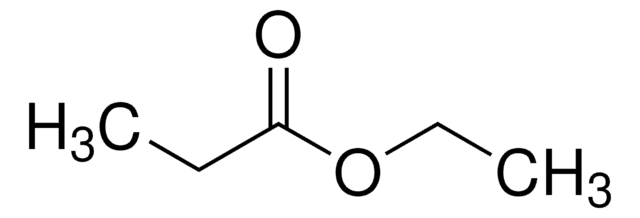88554
Ethyl formate
analytical standard
Synonym(s):
Formic acid ethyl ester
About This Item
Recommended Products
grade
analytical standard
Quality Level
vapor density
2.5 (vs air)
vapor pressure
15.16 psi ( 55 °C)
3.79 psi ( 20 °C)
Assay
≥99.5% (GC)
autoignition temp.
851 °F
shelf life
limited shelf life, expiry date on the label
expl. lim.
16 %
technique(s)
HPLC: suitable
gas chromatography (GC): suitable
refractive index
n20/D 1.359 (lit.)
n20/D 1.360
bp
52-54 °C (lit.)
mp
−80 °C (lit.)
density
0.921 g/mL at 20 °C (lit.)
application(s)
agriculture
cleaning products
cosmetics
environmental
flavors and fragrances
food and beverages
personal care
format
neat
SMILES string
CCOC=O
InChI
1S/C3H6O2/c1-2-5-3-4/h3H,2H2,1H3
InChI key
WBJINCZRORDGAQ-UHFFFAOYSA-N
Looking for similar products? Visit Product Comparison Guide
General description
Application
Recommended products
Signal Word
Danger
Hazard Statements
Precautionary Statements
Hazard Classifications
Acute Tox. 4 Inhalation - Acute Tox. 4 Oral - Eye Irrit. 2 - Flam. Liq. 2 - STOT SE 3
Target Organs
Respiratory system
Storage Class Code
3 - Flammable liquids
WGK
WGK 1
Flash Point(F)
-4.0 °F - closed cup
Flash Point(C)
-20 °C - closed cup
Personal Protective Equipment
Choose from one of the most recent versions:
Certificates of Analysis (COA)
Don't see the Right Version?
If you require a particular version, you can look up a specific certificate by the Lot or Batch number.
Already Own This Product?
Find documentation for the products that you have recently purchased in the Document Library.
Articles
Butyl methyl ether; Acetic acid; 2-Butanone; Ethyl acetate; Tetrahydrofuran; 1-Butanol; Isopropyl acetate; Heptane; Propyl acetate; 3-Methylbutanol; 4-Methyl-2-pentanone; Isobutyl acetate; Butyl acetate; Dimethyl sulfoxide; Anisole; Cumene
Protocols
Protocol for GC Analysis of Class 3 Residual Solvents on SUPELCOWAX® 10
Our team of scientists has experience in all areas of research including Life Science, Material Science, Chemical Synthesis, Chromatography, Analytical and many others.
Contact Technical Service









